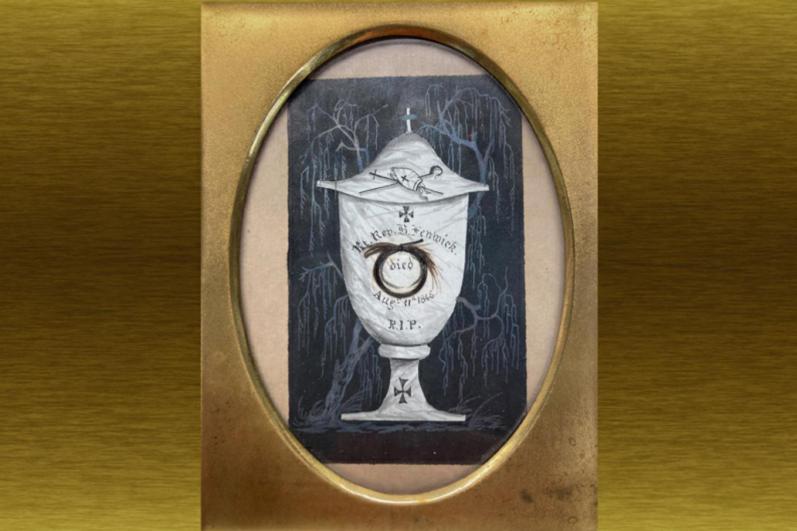August marks 175th anniversary of Bishop Fenwick's death
Wednesday, Aug. 11, marked the 175th anniversary of the death of Boston's second bishop, Benedict Joseph Fenwick.
Bishop Fenwick's 1846 death was preceded by a lengthy period of illness, caused by various cardiovascular maladies. In December of 1845, physicians diagnosed the bishop with "enlargement of the heart" (cardiomegaly) and the following month with severe "dropsy" (swelling of the soft tissue, usually related to an underlying heart condition such as congestive heart failure). Despite living with near constant pain and discomfort, Bishop Fenwick carried out his duties and kept up his travel schedule until about a week before his death, when his condition worsened, markedly during a mid-summer heat wave.
Bishop John Bernard Fitzpatrick, Bishop Fenwick's successor and coadjutor bishop of Boston since 1843, administered last rites to Bishop Fenwick on Aug. 8. Word travelled throughout Boston and beyond that Bishop Fenwick had entered his final days. In a surprising move of compassion, Mayor of Boston Josiah Quincy, Jr. -- himself a member of one of the city's most prominent Brahmin families -- ordered the streets around the Cathedral of the Holy Cross to be closed to wheeled traffic, so as not to disturb the dying Catholic bishop. Bishop Fitzpatrick, the clergy of the Cathedral of the Holy Cross, and a group of women religious kept vigil at Bishop Fenwick's bedside until his death on Aug. 11.
Bishop Fenwick's death was an occasion of large-scale public mourning. His body lay in state at the cathedral for two days, during which an estimated 50 thousand visitors paid their respects. During his funeral mass, a crowd of 10 thousand assembled in the cathedral and on its surrounding streets. In an early show of interfaith goodwill, the bell of the Federal Street Unitarian Church tolled for the Catholic bishop. Four years earlier, Bishop Fenwick had ordered that the bells of the Catholic cathedral toll to mark the death of the Unitarian minister William Ellery Channing. Following the funeral mass, a long procession of clergy and laypeople, chanting and singing psalms, escorted the bishop's body through the streets of Boston to the railway station. Hundreds made the further journey by special train to Worcester, where Bishop Fenwick was to be buried at the College of the Holy Cross Cemetery.
These displays of mourning were remarkable at a time when anti-Catholic sentiment remained rampant in Boston and indeed throughout the country. Bishop Fenwick's death came only a decade after a Catholic convent in Charlestown was burned to the ground by a hysterical Protestant mob convinced by nativist propaganda that it was a den of immorality and deviance.
An effigy of Bishop Fenwick had been publicly shot at in 1835, Catholics and Protestants clashed in the bloody Broad Street Riot of 1837, and Bishop Fenwick regularly received death threats until the end of his life. In the years after Bishop Fenwick's death, the anti-Catholic "Know Nothing" Party would rise to national prominence, finding widespread support among Boston's Protestants. Given this context, Bishop Fenwick's very public funerary exercises marked a rare moment of peace between Boston's Catholic and Protestant populations.
A feeling of surprise for this peace is palpable in Bishop Fitzpatrick's public statement of thanks to the citizens of Boston, published in the Aug. 22, 1846, edition of The Pilot:
"The Catholic Bishop of Boston cannot refrain from a public expression of the gratitude felt by himself, and by the community of which he is the head, for the kind regard recently evinced towards them by the city authorities, and by their fellow Citizens in general. The attention of the authorities to guard from all molestation in the hour of sickness and agony one whom we loved, was equally grateful to him and to us. The decorum which prevailed, and the respect which was manifested by all classes of citizens during the religious procession of the obsequies through our most public streets, could not have been surpassed in a community even exclusively Catholic. We are thankful for so much kindness, and we feel Impelled to speak out our thanks."
If the death of Bishop Fenwick prompted an outpouring of public grief, it was also the impetus for more private mourning rituals. Historians have noted that the Victorian era, during which Bishop Fenwick died, marked the rise of the "cult of the dead" -- a preoccupation with death and mourning marked by new social traditions and, most visibly, by the creation of death-related ephemera, such as mourning clothing, jewelry, cards, and artwork.
The archive maintains a framed mourning card for Bishop Fenwick that is typical of the era; it depicts a chalice inscribed with the text "Rt. Rev. B. Fenwick, died Aug. 11, 1846. R.I.P." Affixed to the card is a small lock of Bishop Fenwick's hair, which even 175 years after his death retains its chestnut brown color. In the 19th century, mourning jewelry and art often contained hair -- an apt symbol to commemorate the dead, since hair is "dead" even when still attached to a living body. Furthermore, as the lock of Bishop Fenwick's hair demonstrates, under the right conditions, hair can retain its color for centuries after it is removed from the body.
Although the practice of creating hair art and jewelry arose in a largely secular context, for Catholics, it was intimately linked to the belief in the Resurrection of the Body. Inhabiting a space between decay and permanence, it pointed to the Last Day, when mortal bodies will return, glorified, to new life.
As we commemorate the 175th anniversary of the death of Bishop Fenwick, we pray that his soul and the souls of all the faithful departed, through the mercy of God, rest in peace.
VIOLET HURST IS AN ARCHIVIST FOR THE ARCHDIOCESE OF BOSTON.



















